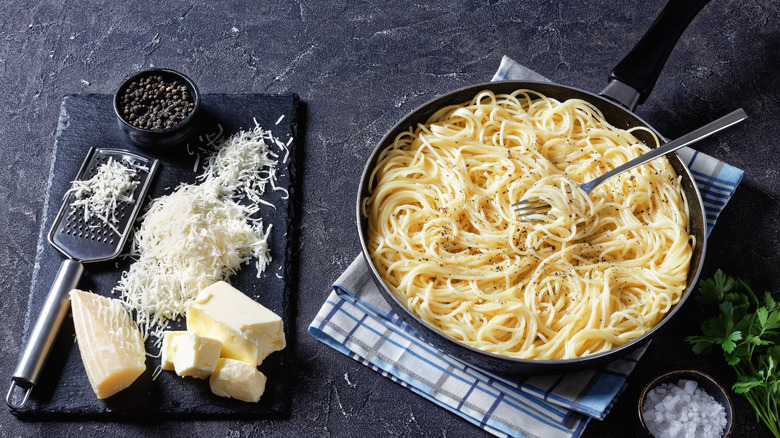How A Splash Of Dairy May Improve Your Cacio E Pepe Texture
No matter which way you twirl it, there is no denying that cacio e pepe is the definitive Roman pasta. The ingredients for this classic are simple: pasta, black pepper, and Pecorino Romano cheese. The cooked pasta is mixed together with the cheese and pepper to create a creamy infusion that is bound to fill stomachs. Despite the seeming ease, however, the texture of this dish can be somewhat tricky to get right.
Pecorino Romano is one half of the duo of star ingredients that make cacio e pepe so tasty. Unfortunately, it does have a tendency to clump. This is thanks to the cheese's lipoproteins. Lipoproteins are molecules within dairy that prevent fats and proteins from separating. They are also soluble, which means that they will incorporate easily when mixed together with liquid. Since Pecorino is an aged cheese, by the time it's ready to go into your pasta, the lipoproteins are significantly broken down. Hence why the cheese is prone to clumping.
Fortunately, there is an easy way around this. Though purists may scoff at introducing any additional ingredients to this traditionally low-ingredient meal, a little cream can go a long way towards working out the clumps and improving the texture of your pasta.
Add a splash of cream to prevent clumping
As cream is a dairy product, it maintains a similar molecular structure to Pecorino cheese. The difference lies in the fact that cream is a fresh product, meaning that its own lipoproteins have not broken down yet and are already well incorporated within the liquid. Adding a splash of cream into the mixture provides a liquid base for the Pecorino lipoproteins to dissolve in, thereby allowing the cheese to melt evenly.
Of course, the quality of the Pecorino also plays a major role in the process. Whenever possible, aim for using freshly grated cheese as opposed to pre-packaged. The latter are often treated with preservatives that inhibit the lipoproteins, making them less soluble than the freshly grated stuff. When you grate the cheese, be sure to use the finest part of the cheese grater. This will produce a powdery cheese that is easier to melt than the larger flakes you get from the larger holes. The larger pieces of cheese are also more likely to clump.
A smooth sauce that coats the pasta is the key to a great cacio e pepe. Having big clumps of cheese in your pasta, though undoubtedly tasty, only serves to ruin this effect. So, though it may not be the classic way of doing it, add that splash of cream to your pasta. Your sauce, and your taste buds, will thank you for it.

